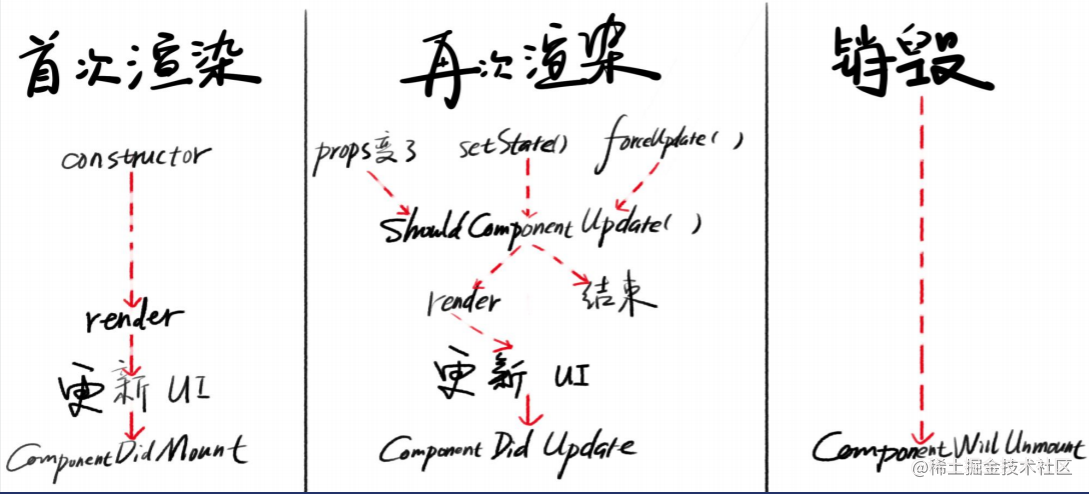钩子函数列表
- constructor()
- shouldComponentUpdate()
- render()
- componentDidMount()
- componentDidUpdate()
- componentWillUnmount()
constructor
组件出现在内存
- 组件创建后会执行该代码
- 初始化 props
- 初始化 state,此时不能调用 setState
- 可写 bind this
constructor(){
this.onClick = this. onClick.bind(this)
}
可被代替为:
constructor(){}
onClick = ()=> {}
shouldComponentUpdate
是否应该更新组件
- 返回 false 阻止 UI 更新
- 返回 true 不阻止 UI 更新 举个例子:写一个加1之后立即减1的操作
class App extends React.PureComponent {
constructor(props) {
super(props);
this.state = {n: 1}
}
onClick = () => {
this.setState(state => ({n: state.n - 1}))
this.setState(state => ({n: state.n + 1}))
}
render(){
console.log('变化了一次')
return (
<div>
{this.state.n}
<button onClick={this.onClick}>+1-1</button>
</div>
)
}
}
你无论点击多少次页面都没有变化。而控制台一直都在 log ,即每次都在 render 。这是为什么?
- 每次 setState 都会产生新对象,即使对象的内容相同。
- {n:1} 和 {n:1} 不是同一个对象。
- React 发现对象不同,将会 render 渲染组件,在DOM Diff 过程中发现新渲染的组件和旧组件内容相同,就不更新页面内容。
- 因此页面无变化,但是 render 的确每次都执行了。
- 如何减少不必要的 render?
使用 shouldComponentUpdate
- 由于对象地址不同,react 认为数据变了,执行 render。
- 该函数就是用通过新旧 state 内容是否相等来决定是否要执行 render 从而减少不必要的 render。
- 即是否阻止 UI 更新
shouldComponentUpdate(nextProps, nextState, nextContext) {
if(nextState.n ===this.state.n){
return false
}else{
return true
}
}
React 为此内置了此功能。
React.PureComponent
- 可代替React.Component,自动检查是否更新 UI,是 React 内置的功能。
- PureComponent 会在 render 之前对比新 state 和旧 state 的每一个 key,以及新 props 和旧 props 的每一个 key。
- 如果所有 key 的值全都一样,就不会 render,告诉 react 不更新;如果有任何一个 key 的值不同,就会 render。
class App extends React.PureComponent
render
创建虚拟 DOM
- 展示视图 渲染页面
- 只能有一个根元素
- 若有两个根元素,要用 <React.Fragment> 包起来
- 可用 </> 代替 <React.Fragment/>,你会发现 这只是起一个占位符作用
componentDidMount
组件已经出现在页面
- 在元素插入页面后执行的代码,这些代码依赖 DOM
- 页面首次渲染会执行此钩子
- 可以发起加载数据的 AJAX 请求 举个栗子:获取 div 的宽度
class App extends React.PureComponent {
constructor(props) {
super(props);
this.state = {width:undefined}
}
componentDidMount() {
const div = document.getElementById('x')
const {width} = div.getBoundingClientRect()
this.setState({width})
}
render(){
return ( <div id='x'>{this.state.width}</div>)
}
}
由于使用 id 的重复冲突率较高,我们一般使用 ref 代替 id 获取节点
class App extends React.PureComponent {
divRef = undefined // 初始化
constructor(props) {
super(props);
this.state = {width:undefined}
this.divRef = React.createRef() // 创建 ref
}
onClick = () => {
this.setState(state => ({n: state.n - 1}))
this.setState(state => ({n: state.n + 1}))
}
componentDidMount() {
const div = this.divRef.current // 获取绑定的节点
const {width} = div.getBoundingClientRect()
this.setState({width})
}
render(){
return (<div ref={this.divRef}>{this.state.width}</div>) // 使用
}
}
componentDidUpdate
组件已更新
- 在视图更新后执行代码
- 首次渲染不会执行此钩子
- 可以发起 AJAX 请求,用于更新数据
- 写在此处的 setState 可能会引起无限循环,除非有 if
- 若 shouldComponentUpdate 返回 false,则不会触发此钩子
conponentWillUnmount
组件将消失
- 组件将要被移除页面然后被销毁时执行的代码
- 例:如果在 componentDidMount 创建了 Timer,就要在这里取消了。